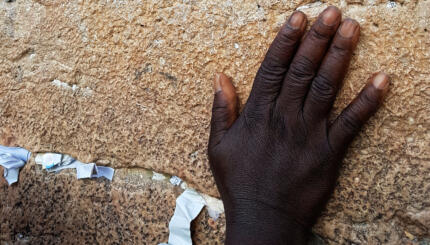Reprinted with permission from Becoming a Jew (Jonathan David Publishers, Inc.).
The two pivotal "performative" components of the act of conversion–circumcision and immersion–cannot serve as a complete conversion independently for a male convert. Although they constitute different religious symbols and occupy different spiritual moments in the conversion process, they are nonetheless intimately linked, both conceptually and halakhically [according to Jewish law].
Conversion Means Acceptance of Jewish Fate and Destiny
Conceptually, circumcision and immersion respectively represent the two aspects of "entering the covenant" encompassed by the Sinaitic Covenant–the first immediately prior to the Exodus when the Jews were circumcised in preparation for leaving Egypt; the second at Sinai itself when all the Jews collectively were confronted by God. In both instances, the Jews united in a covenant. In Egypt, the Jews united for their self-defense, to protect each other and to come under the protection of God–their common fate, goral. At Sinai, they united in order to become a "priestly people," to accomplish together their God-given role and to achieve a common destiny, ye’ud.
Exodus is a person-to-person covenant, Sinai a God-people covenant. When Jewish tradition refers to a convert "entering the covenant," it refers to accepting the double goal of the covenant–fate and destiny–of becoming a part of the people by wanting to share the Jewish fate as our ancestors did in Egypt, and of standing in the presence of God to share the Jewish destiny as our ancestors did at Sinai.

Help us keep Jewish knowledge accessible to millions of people around the world.
Your donation to My Jewish Learning fuels endless journeys of Jewish discovery. With your help, My Jewish Learning can continue to provide nonstop opportunities for learning, connection and growth.
Circumcision represents the fate-sharing component of conversion. It returns the person to the soil of pre-Exodus Egypt before the Jews became a distinct people and recalls the beginning of the conversion of the whole people. It embodies the convert’s full-hearted consent to be part of a united global people–its history and its future–and to be willing to suffer when any part of that people suffers, as the mind must cringe when the hand is cut.
Immersion represents the desire to share in a collective relationship with God, to participate in the Jewish religious destiny as the chosen people of God. Its origin recalls the desert foothills of Mt. Sinai where the Jews were told by Moses to wash in preparation for receiving the Torah. This was designed to be the climax of the conversion procedure. From that time forward, the ceremony of mikveh [ritual pool] immersion, whether performed in Jerusalem, Warsaw, or Los Angeles, was intimately linked with the moment at Sinai and the commitment to accept the precepts of Torah; it became for all time the ceremonial sign of sharing the destiny. It was the "religious" component, the standing in the presence of God, the leap of faith, the total commitment.
As soon as immersion occurred, with its prerequisite acceptance of mitzvot [commandments], the two-phased process was completed. The gentile became a Jew–an integral, covenanted member and full participant in the fate and destiny of the Jewish people. Conversion was complete.
What was required for men–circumcision to recall the peoplehood covenant at Egypt, in addition to immersion required for all converts–was not required for women. Naturally, both men and women are equally and fully partners in the covenant. But women’s acceptance of the religious destiny of the Jews is thought to embrace also acceptance of sharing in the communal fate of the Jews. The "daughters of Israel," as Jewish women are fondly called in the literature, are thought to need no physical mark to remind them of their identity with the people; it is believed to be part of their souls, unlike men who need the reminder to be carved on the most intimate part of their bodies.


